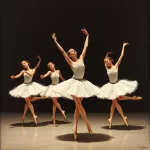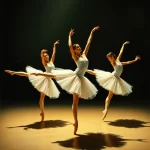Ballet: Elite Syncopations (Scott Joplin, 1974)

Introduction
Ballet: Elite Syncopations is a vibrant and lively ballet choreographed by Sir Kenneth MacMillan, set to the ragtime music of Scott Joplin. Premiered on October 7, 1974, by The Royal Ballet at the Royal Opera House in London, this one-act ballet is a delightful departure from traditional classical ballet, embracing the playful and syncopated rhythms of early 20th-century American music. The ballet does not follow a strict narrative but instead presents a series of dance vignettes that capture the spirit and energy of the ragtime era.
Historical Background
Creation and Development
Elite Syncopations was created during a period when choreographers were exploring new ways to innovate and break away from the classical ballet mold. The 1970s saw a surge in interest in diverse musical genres and cultural influences, and MacMillan was inspired by the lively and syncopated rhythms of ragtime music. The ballet’s title is derived from one of Scott Joplin’s compositions, “Elite Syncopations,” which is featured prominently in the score.
MacMillan collaborated closely with the composer and arranger Robert Docker, who orchestrated Joplin’s piano rags for a small ensemble. The ballet’s creation was also influenced by the social and artistic movements of the time, which emphasized experimentation and a blending of high and popular art forms.
Premiere and Reception
Elite Syncopations premiered on October 7, 1974, at the Royal Opera House in London. The initial reception was overwhelmingly positive, with critics and audiences praising the ballet’s originality, humor, and infectious energy. The ballet’s playful and accessible nature made it an instant hit, and it quickly became a staple in The Royal Ballet’s repertoire.
Notable early performances included revivals by other major ballet companies, such as the American Ballet Theatre and the Australian Ballet, further cementing its status as a beloved work in the ballet canon.
Synopsis of the Ballet
Elite Syncopations is a one-act ballet that consists of a series of dance vignettes set to various ragtime compositions by Scott Joplin and other composers of the era. The ballet does not follow a strict narrative but instead presents a lively and colorful depiction of a ragtime dance hall, where dancers showcase their skills and personalities through a series of solos, duets, and ensemble numbers.
Key Moments or Scenes
- Opening Ensemble: The ballet opens with a lively ensemble number, introducing the dancers and setting the tone for the evening’s festivities.
- Solos and Duets: Throughout the ballet, various dancers perform solos and duets, each showcasing their unique style and character. Notable pieces include “The Golden Hours,” “Stop-Time Rag,” and “The Cascades.”
- Finale: The ballet concludes with a rousing ensemble number, bringing all the dancers together for a joyous and energetic finale.
Musical Composition
Composer’s Role
Scott Joplin, known as the “King of Ragtime,” composed the majority of the music featured in Elite Syncopations. Joplin’s compositions, characterized by their syncopated rhythms and lively melodies, provide the perfect backdrop for MacMillan’s choreography. Robert Docker’s orchestration of Joplin’s piano rags for a small ensemble adds depth and texture to the music, enhancing the overall experience of the ballet.
Musical Themes and Motifs
The music of Elite Syncopations is rich with recurring themes and motifs that capture the essence of the ragtime era. The syncopated rhythms and playful melodies create a sense of movement and energy that perfectly complements the choreography. The music enhances the narrative by highlighting the dancers’ personalities and the playful interactions between them.
Famous Recordings and Performances
While there are no widely known recordings of the complete ballet score, individual pieces from the ballet, such as “The Entertainer” and “Maple Leaf Rag,” have been recorded by various artists and orchestras. These recordings capture the spirit of Joplin’s music and provide a glimpse into the lively world of Elite Syncopations.
Choreography and Dance
Choreographer’s Vision
Sir Kenneth MacMillan’s vision for Elite Syncopations was to create a ballet that was both entertaining and accessible, while also showcasing the technical prowess of the dancers. MacMillan’s choreography is characterized by its playful and humorous elements, as well as its intricate footwork and syncopated movements. The ballet’s lighthearted and informal style is a departure from the more serious and dramatic works that MacMillan is known for, demonstrating his versatility as a choreographer.
Signature Dance Numbers
- Pas de Deux: One of the standout moments in the ballet is a charming pas de deux set to Joplin’s “The Entertainer.” The duet is characterized by its playful interactions and intricate partnering work.
- Solo Performances: Several solo performances, such as “The Golden Hours” and “Stop-Time Rag,” showcase the dancers’ technical skills and individual personalities.
- Ensemble Numbers: The ensemble numbers, including the opening and finale, are lively and energetic, featuring intricate group formations and synchronized movements.
Notable Interpretations
Over the years, various productions of Elite Syncopations have brought their own unique interpretations to the choreography. Some productions have emphasized the ballet’s humorous and playful elements, while others have focused on the technical precision and athleticism of the dancers. Notable interpretations include performances by The Royal Ballet, the American Ballet Theatre, and the Australian Ballet, each bringing their own distinct style and flair to the ballet.
Characters and Roles
Main Characters
Elite Syncopations does not have a traditional narrative or central characters, but rather features a cast of dancers who each bring their own unique personalities to the stage. The dancers are often given playful and descriptive names, such as “The Joplin Girl” or “The Cakewalk King,” reflecting their roles in the various dance numbers.
Supporting Characters
In addition to the main dancers, the ballet features a lively ensemble of supporting characters who contribute to the overall energy and atmosphere of the dance hall. These characters often interact with the main dancers, adding depth and complexity to the choreography.
Famous Dancers
Over the years, many notable dancers have performed in Elite Syncopations, bringing their own unique interpretations to the roles. Some of the most famous dancers associated with the ballet include Darcey Bussell, Carlos Acosta, and Marianela Nuñez, all of whom have brought their exceptional talent and charisma to the stage.
Cultural and Artistic Impact
Influence on Ballet and Dance
Elite Syncopations has had a significant impact on the world of ballet and dance, influencing other choreographers and inspiring new works that blend classical ballet with popular music genres. The ballet’s playful and accessible style has helped to broaden the appeal of ballet, attracting new audiences and encouraging a greater appreciation for the art form.
Cultural Significance
The ballet’s celebration of ragtime music and dance has also contributed to its cultural significance, highlighting the importance of this uniquely American art form. Elite Syncopations has been featured in various media, including television broadcasts and documentaries, further cementing its place in popular culture.
Legacy and Revivals
Elite Syncopations continues to be performed and celebrated today, with major revivals by The Royal Ballet and other leading companies. The ballet’s enduring popularity is a testament to its timeless appeal and the lasting impact of MacMillan’s choreography and Joplin’s music.
Iconic Productions
Historic Productions
The original production of Elite Syncopations by The Royal Ballet in 1974 remains one of the most iconic in the ballet’s history. Key figures involved in this production included choreographer Sir Kenneth MacMillan, composer and arranger Robert Docker, and a cast of talented dancers who brought the ballet to life.
Contemporary Productions
Recent productions of Elite Syncopations have continued to captivate audiences with their fresh interpretations and innovative staging. Contemporary productions often incorporate modern elements, such as updated costumes and lighting design, while staying true to the spirit of the original choreography.
Production Design
The production design of Elite Syncopations plays a crucial role in creating the vibrant and lively atmosphere of the ballet. Set designs often feature colorful backdrops and props that evoke the feel of a ragtime dance hall, while costumes are typically bright and playful, reflecting the characters’ personalities and the era’s fashion.
Critical Reception and Reviews
Initial Critical Response
At the time of its premiere, Elite Syncopations received glowing reviews from critics, who praised its originality, humor, and infectious energy. The ballet was lauded for its innovative choreography and the seamless integration of Joplin’s music, with many critics noting its departure from traditional classical ballet as a refreshing and welcome change.
Modern Reviews
Contemporary critics and audiences continue to hold Elite Syncopations in high regard, appreciating its timeless appeal and the skillful execution of its choreography. The ballet remains a favorite among both seasoned ballet enthusiasts and newcomers, thanks to its accessible and entertaining nature. Modern reviews often highlight the ballet’s ability to capture the spirit of the ragtime era while showcasing the technical prowess of the dancers.
Fun Facts and Trivia
Behind-the-Scenes Stories
One interesting anecdote from the original production of Elite Syncopations involves the creation of the costumes. Designer Ian Spurling drew inspiration from the vibrant and eclectic fashion of the ragtime era, resulting in a colorful and eye-catching wardrobe that has become one of the ballet’s signature elements.
Notable Performers
Over the years, many famous dancers have performed in Elite Syncopations, bringing their own unique interpretations to the roles. Notable performers include Darcey Bussell, Carlos Acosta, and Marianela Nuñez, all of whom have left a lasting impact on the ballet’s legacy.
Trivia
- Elite Syncopations is one of the few ballets that features live musicians on stage, adding to the authenticity and energy of the performance.
- The ballet’s title is derived from one of Scott Joplin’s compositions, “Elite Syncopations,” which is featured prominently in the score.
- Sir Kenneth MacMillan, known for his dramatic and often dark ballets, created Elite Syncopations as a lighthearted and playful departure from his usual style.
Conclusion
Summary of the Ballet’s Importance
Elite Syncopations holds a special place in the world of ballet, thanks to its innovative choreography, lively music, and timeless appeal. The ballet’s celebration of ragtime music and dance has helped to broaden the appeal of ballet, attracting new audiences and encouraging a greater appreciation for the art form. Its enduring popularity is a testament to the lasting impact of Sir Kenneth MacMillan’s choreography and Scott Joplin’s music.
Final Thoughts
Elite Syncopations is a delightful and entertaining ballet that continues to captivate audiences with its playful energy and technical brilliance. Whether you are a seasoned ballet enthusiast or a newcomer to the art form, this ballet offers something for everyone. We encourage readers to experience a performance of Elite Syncopations or listen to the score to fully appreciate the magic and charm of this timeless work.
FAQ
What is the central theme of this ballet?
The central theme of Elite Syncopations is a celebration of ragtime music and dance, capturing the lively and playful spirit of the early 20th-century American dance halls.
Who are the main characters in this ballet?
Elite Syncopations does not have traditional main characters but features a cast of dancers who each bring their own unique personalities to the stage.
What is the most famous dance number in this ballet?
One of the most famous dance numbers in Elite Syncopations is the pas de deux set to Scott Joplin’s “The Entertainer,” known for its playful interactions and intricate partnering work.
How long does a typical performance of this ballet last?
A typical performance of Elite Syncopations lasts approximately 30 to 40 minutes, as it is a one-act ballet.
Are there any modern adaptations of this ballet?
While there are no major modern adaptations of Elite Syncopations, contemporary productions often incorporate updated elements such as costumes and lighting design while staying true to the original choreography.
Why is this ballet considered important in the history of dance?
Elite Syncopations is considered important in the history of dance for its innovative choreography, seamless integration of ragtime music, and its role in broadening the appeal of ballet to new audiences. Its playful and accessible style has made it a beloved work in the ballet canon.





